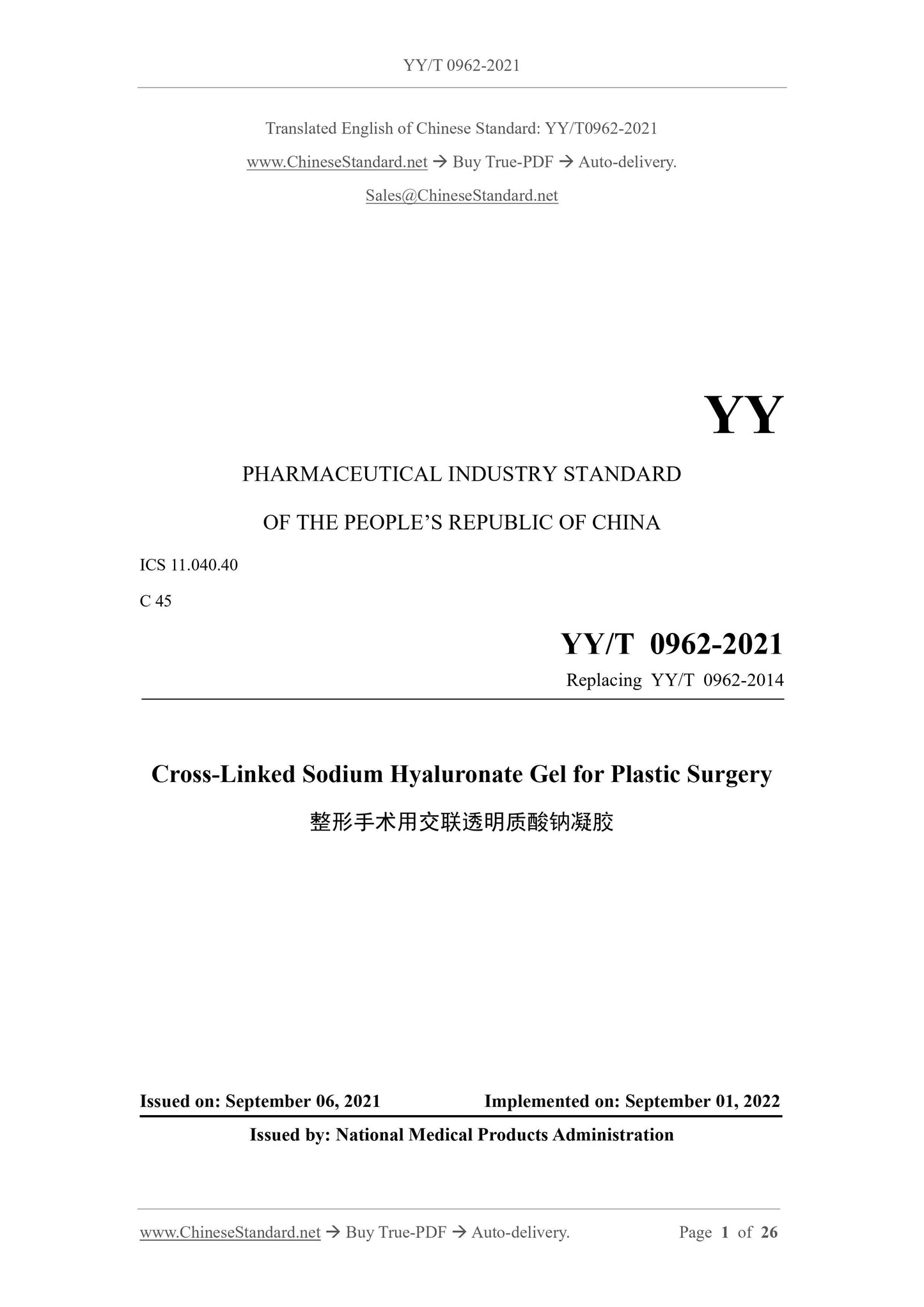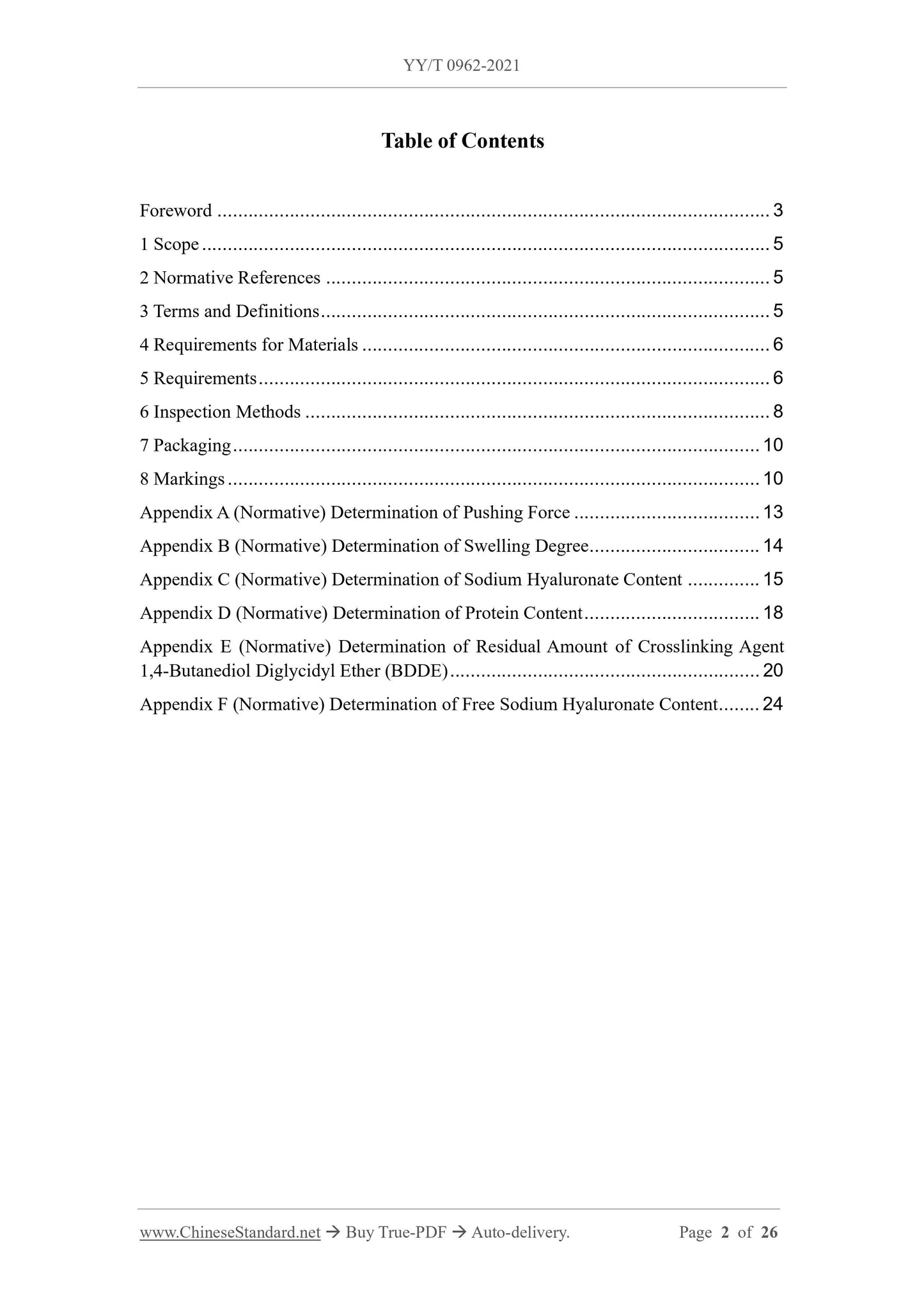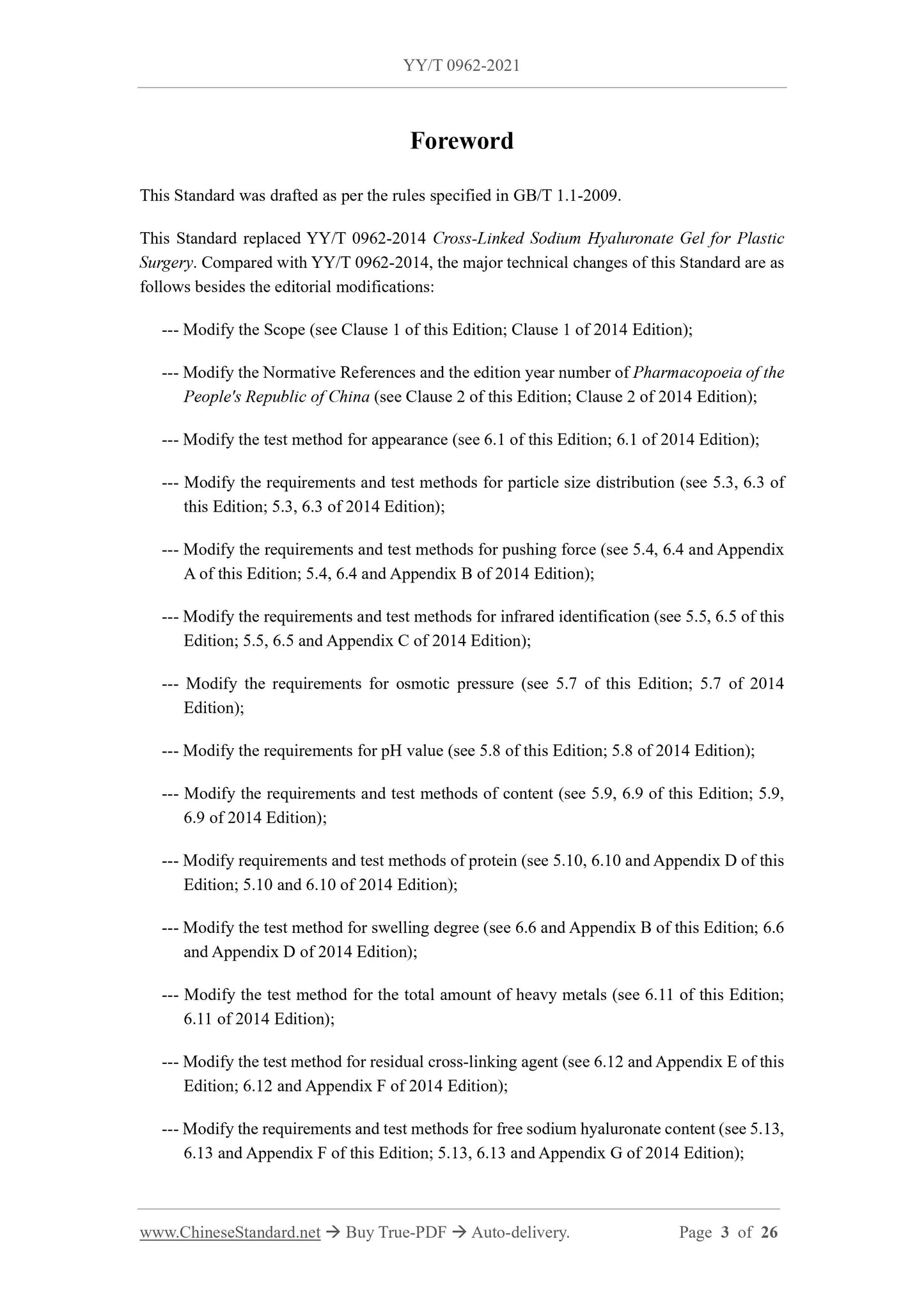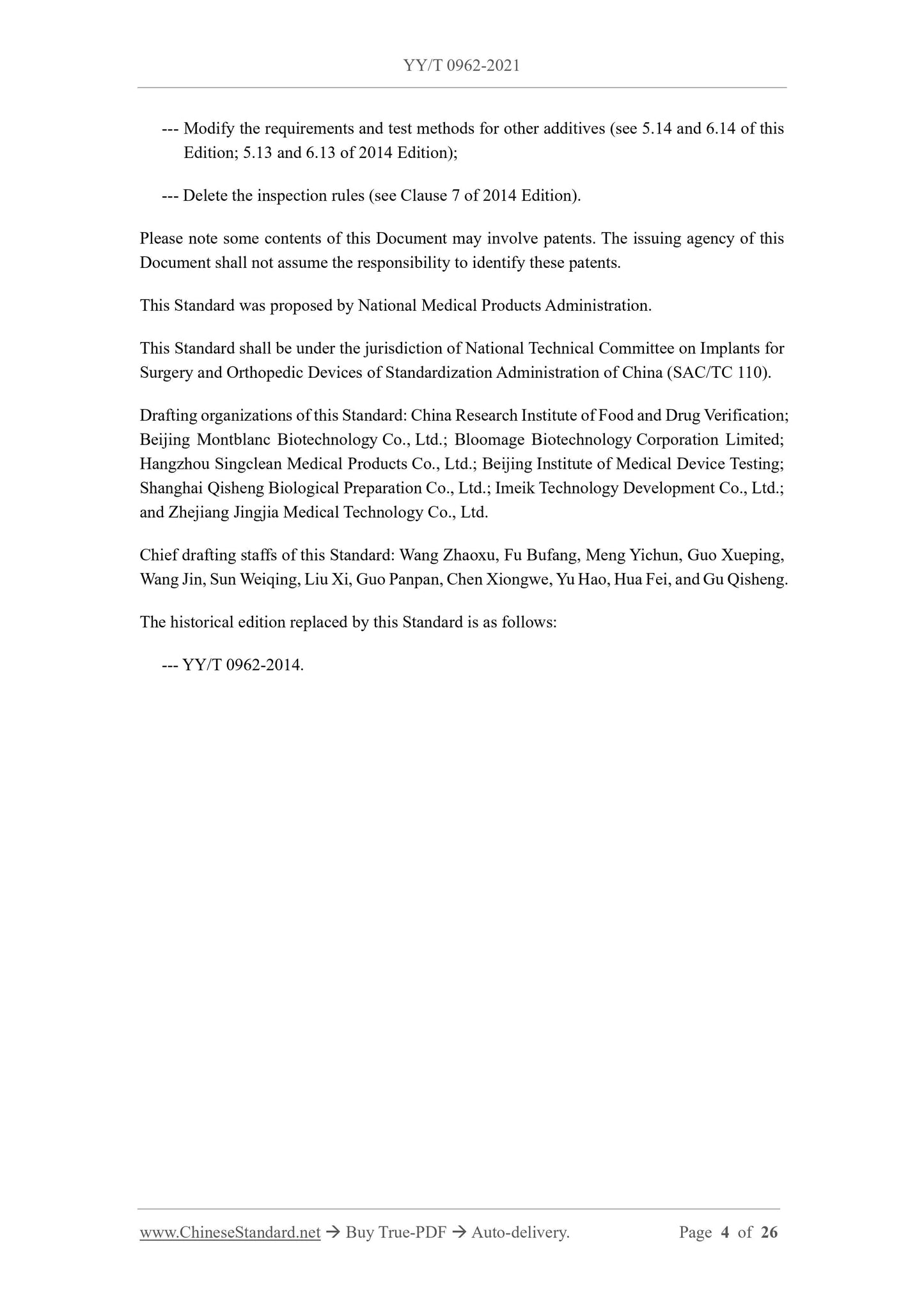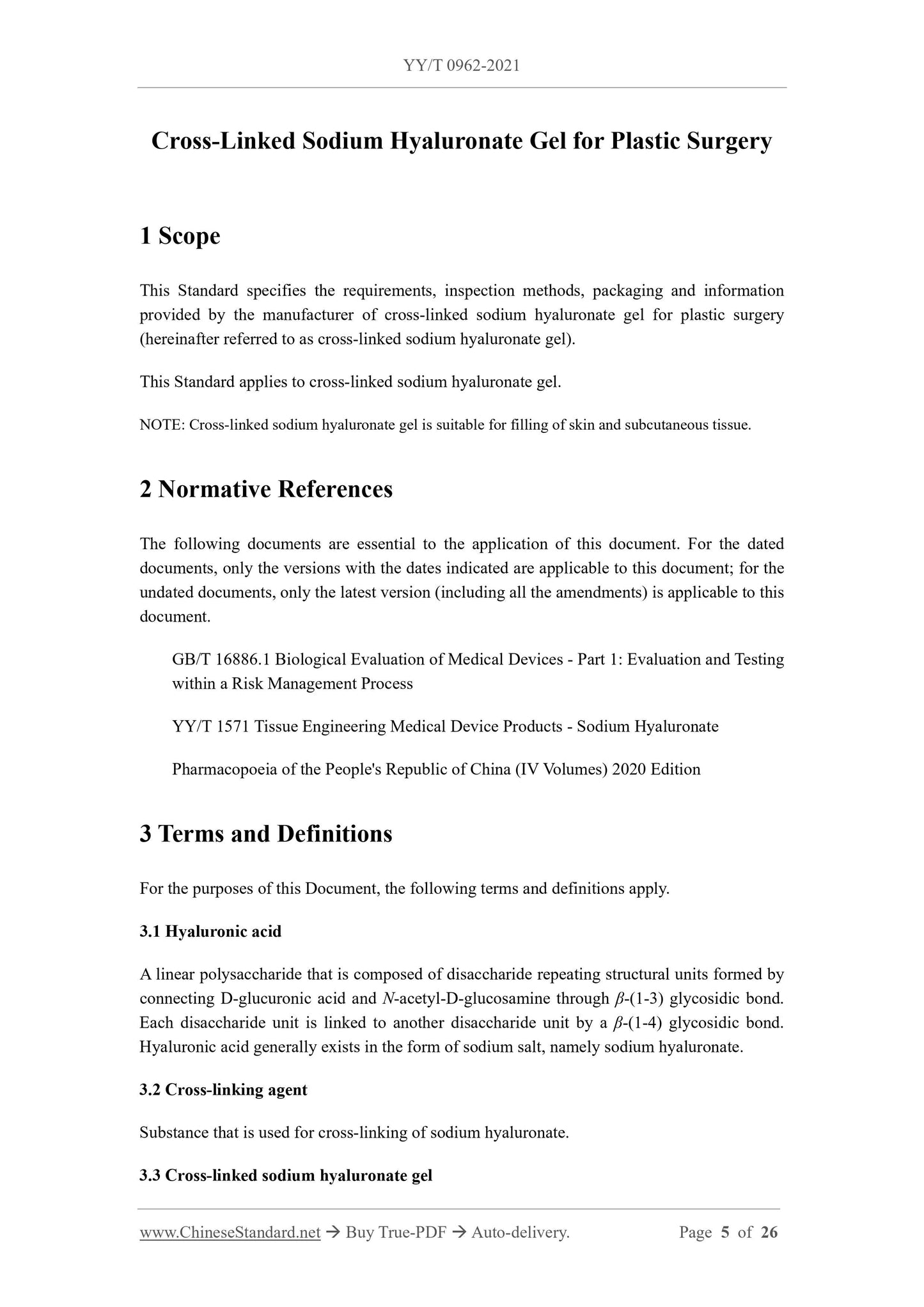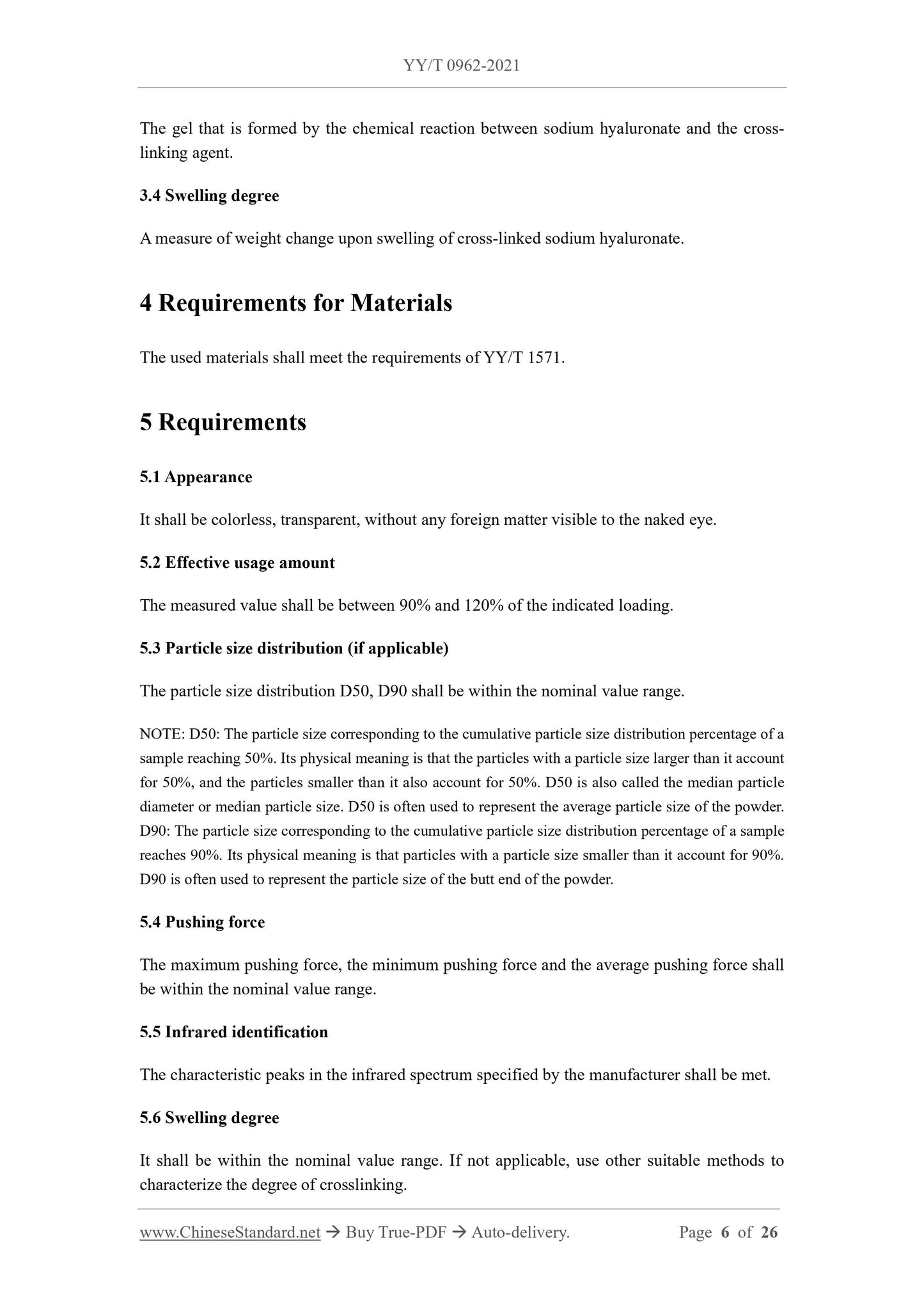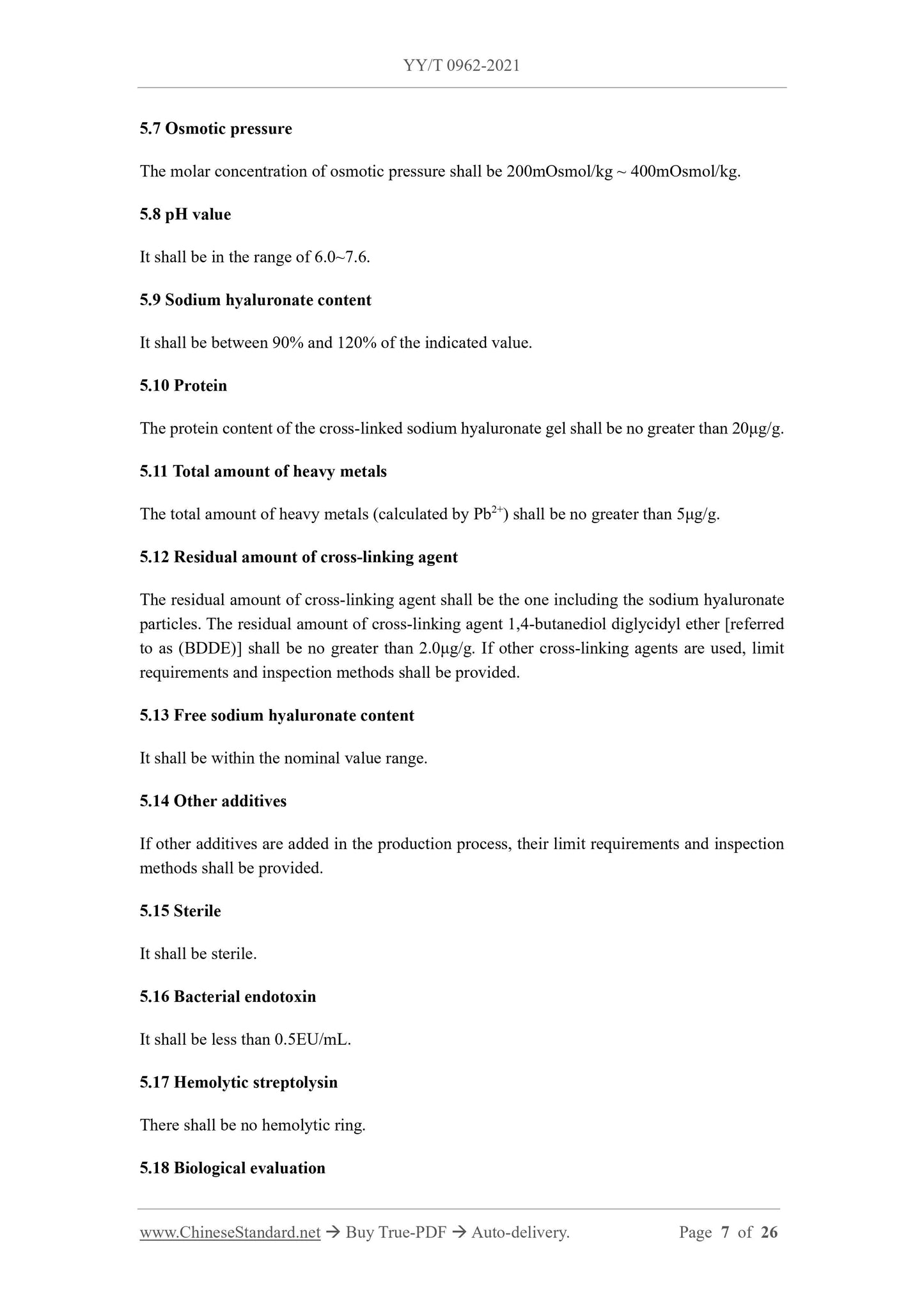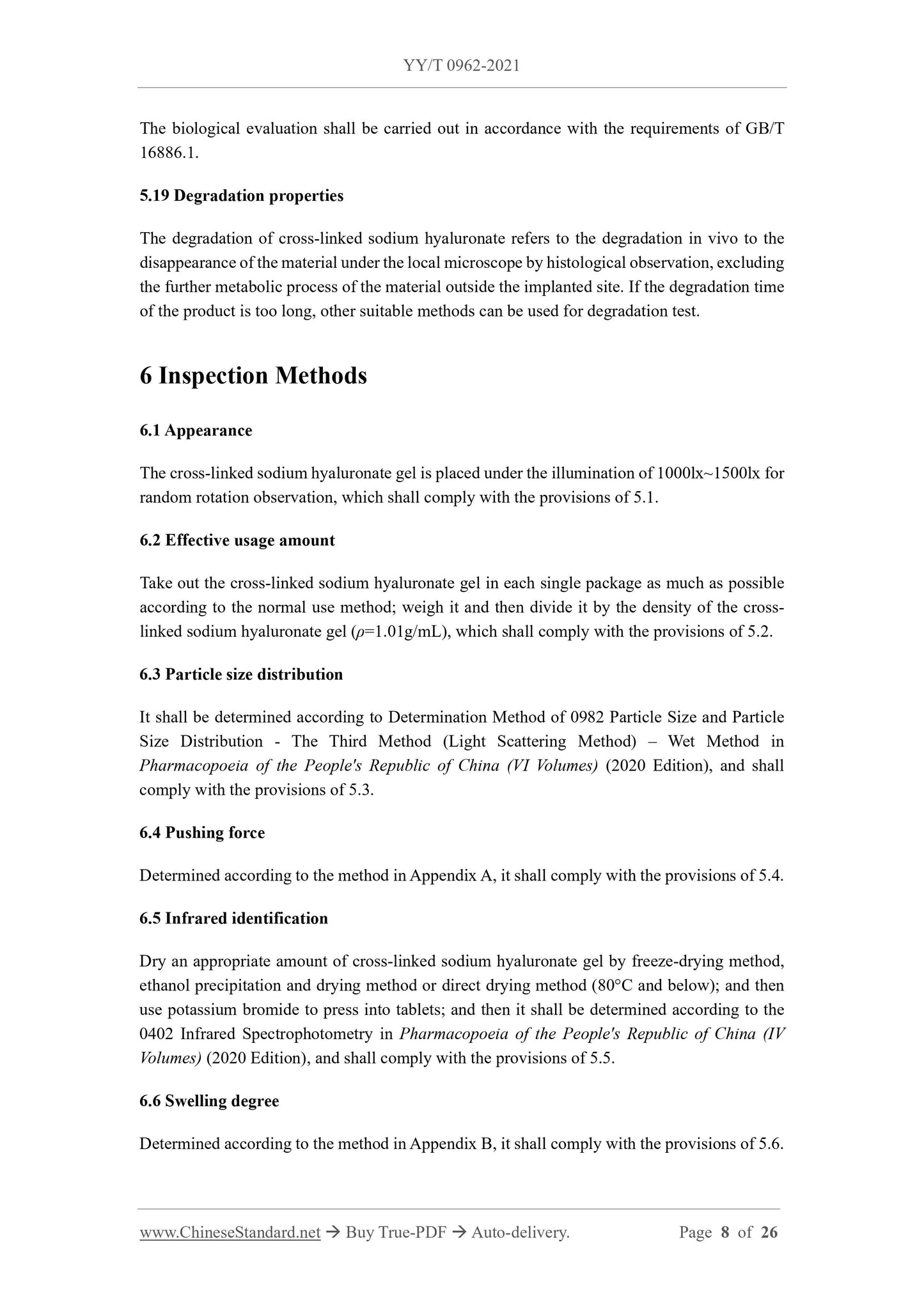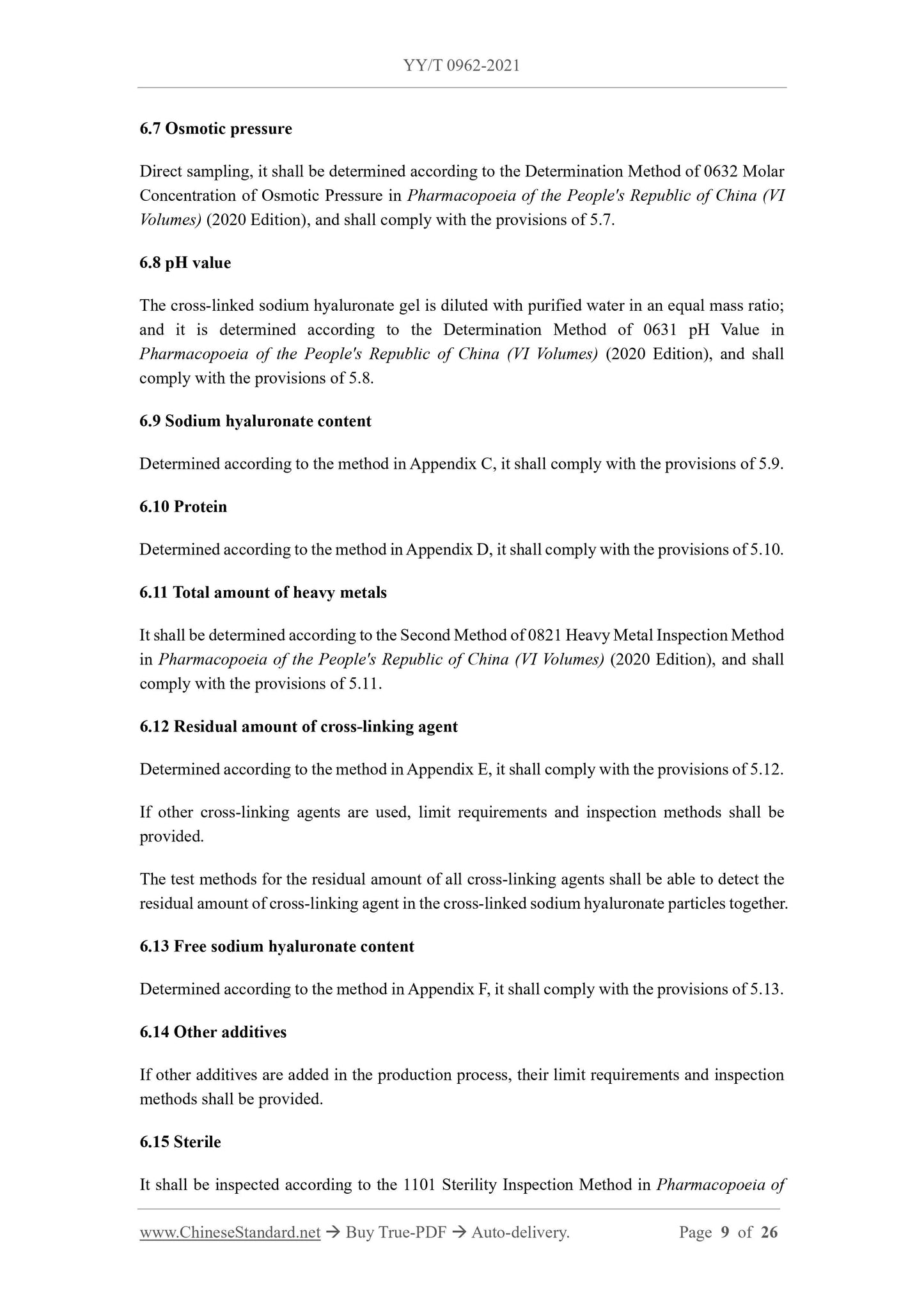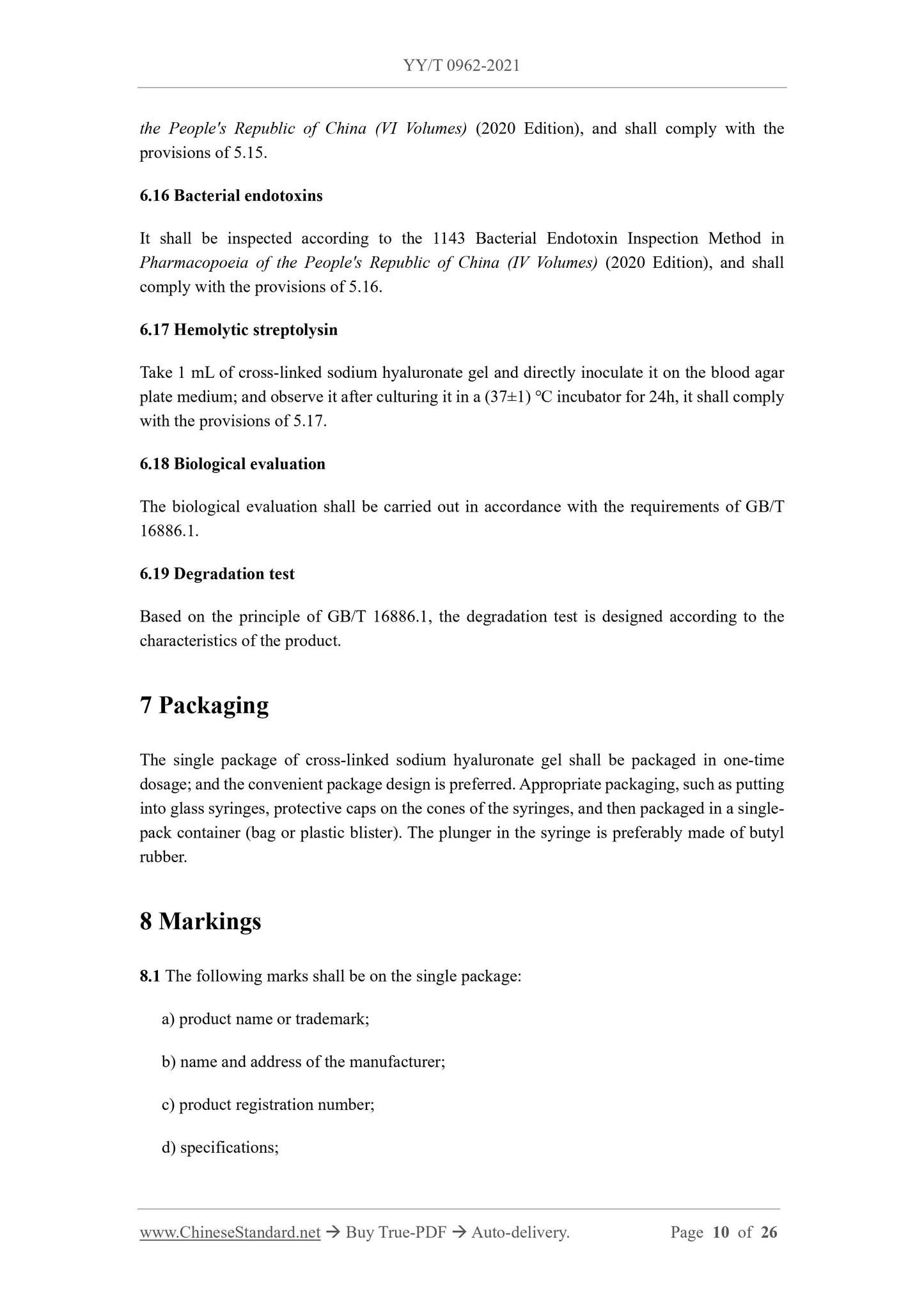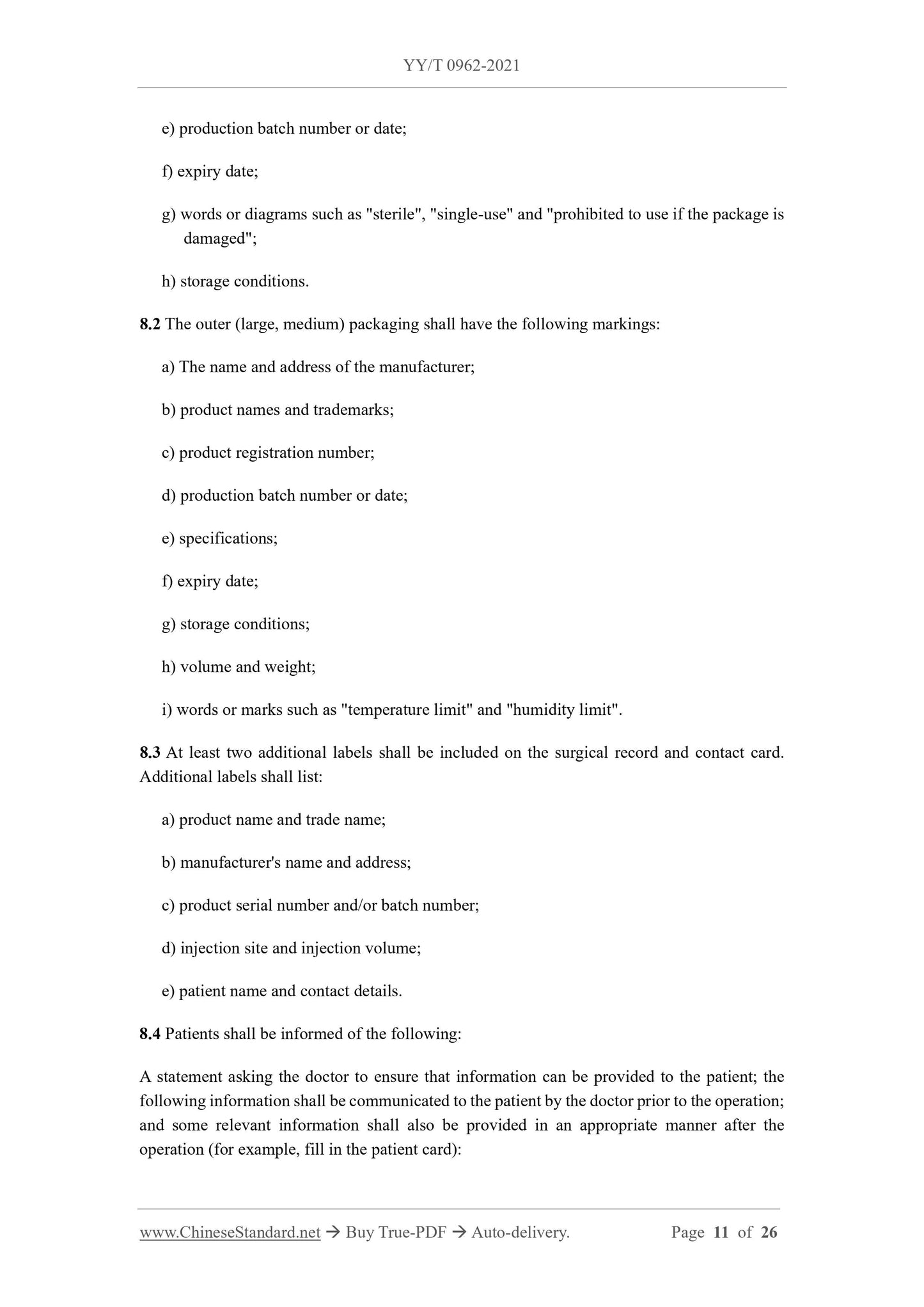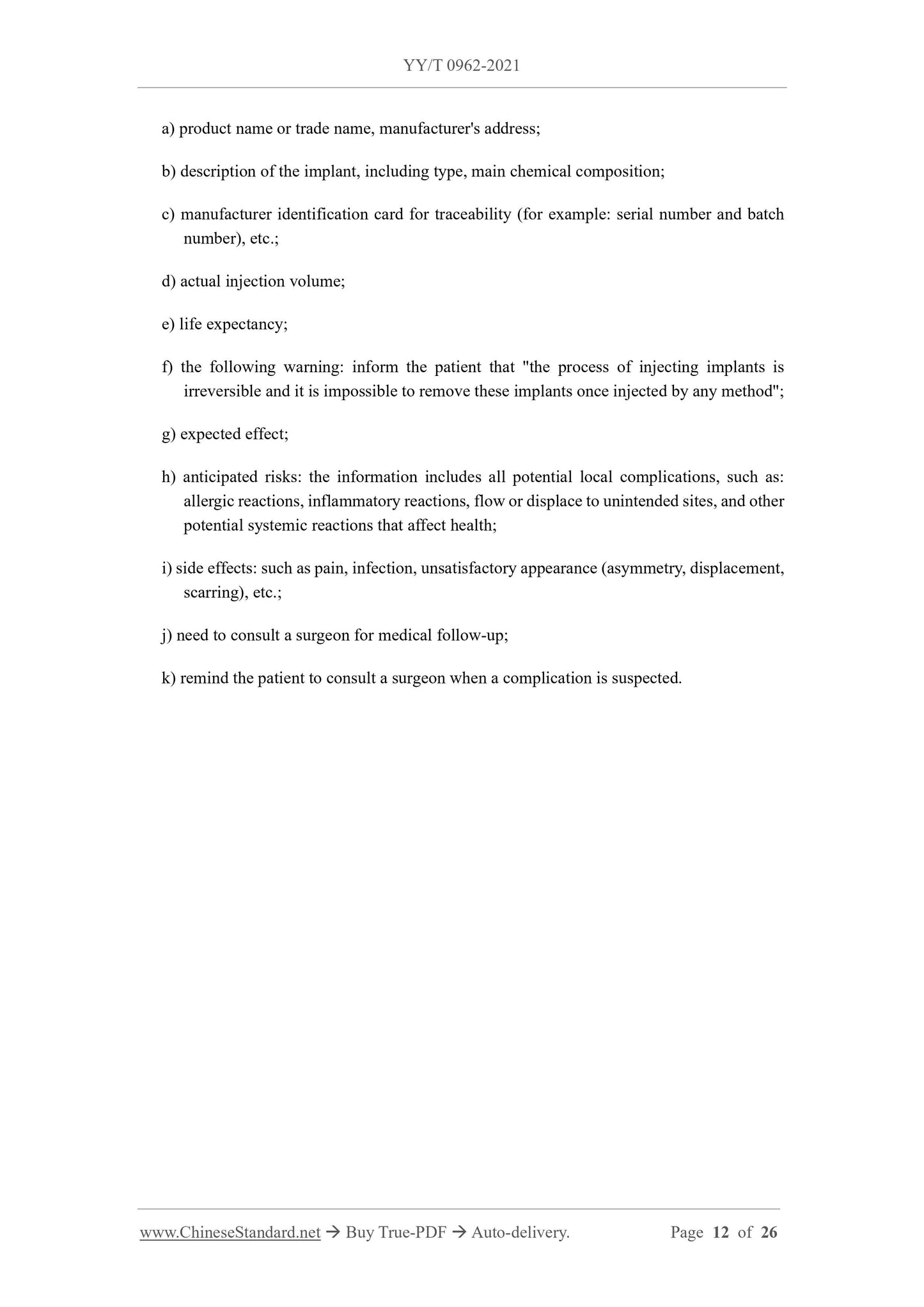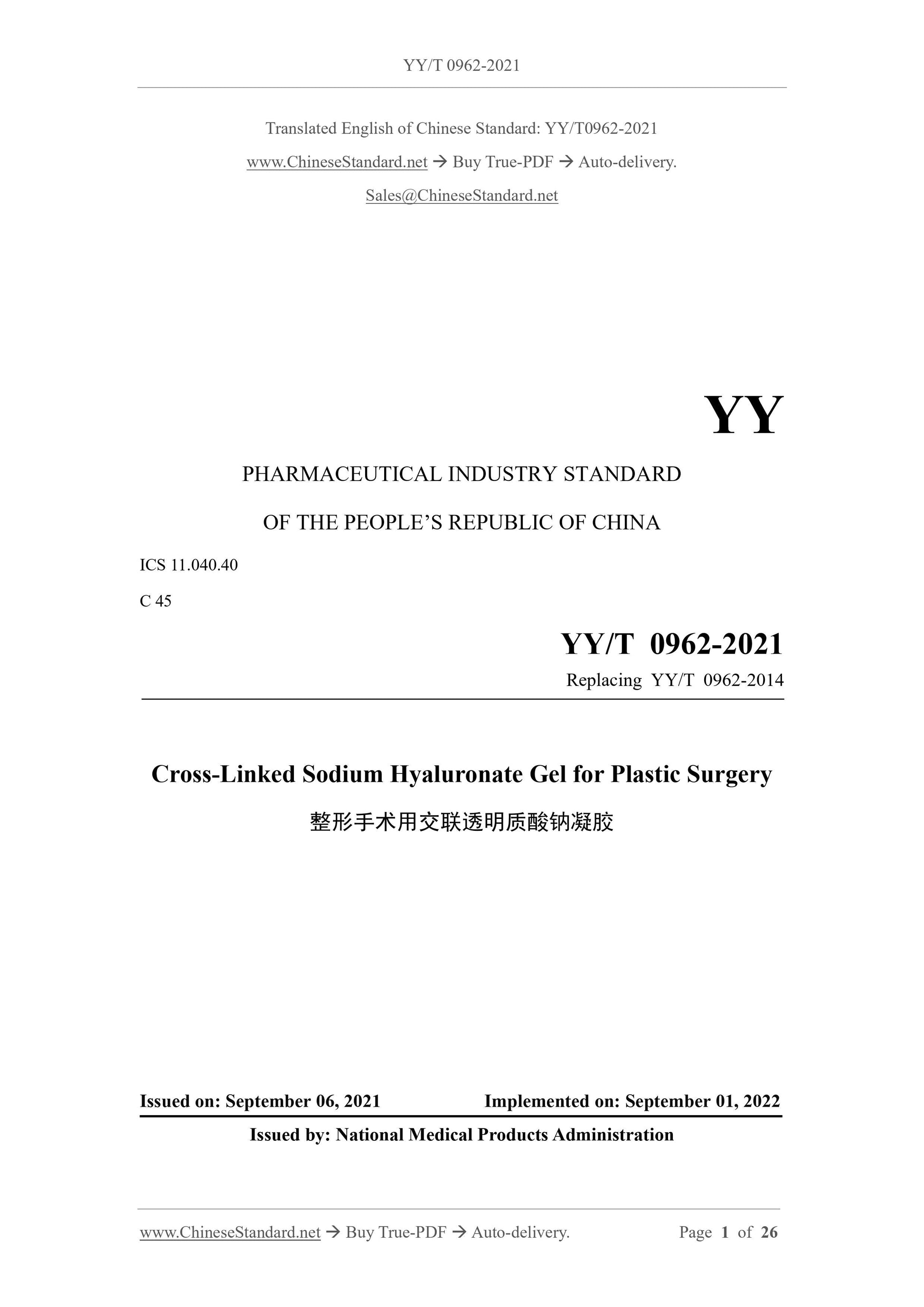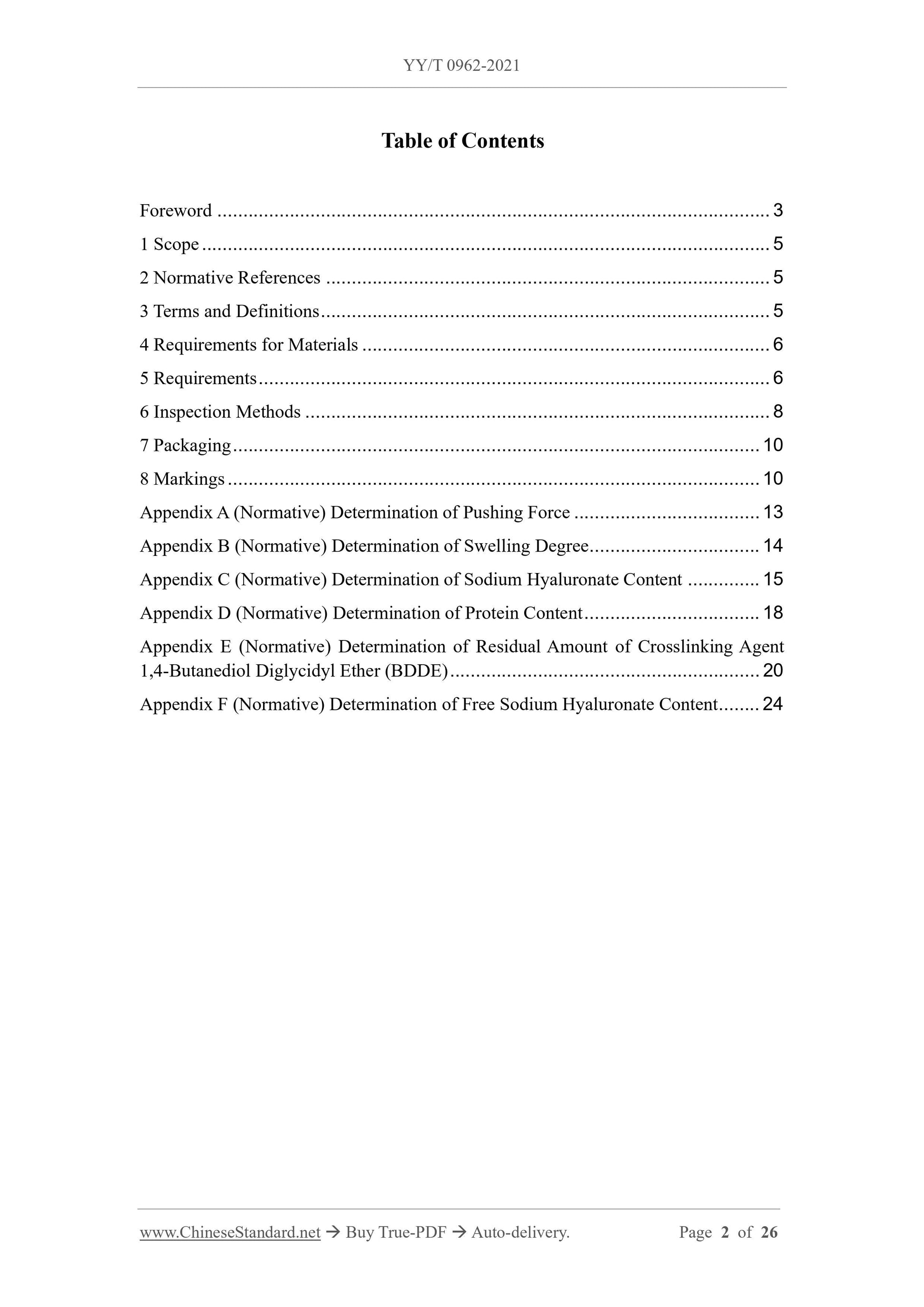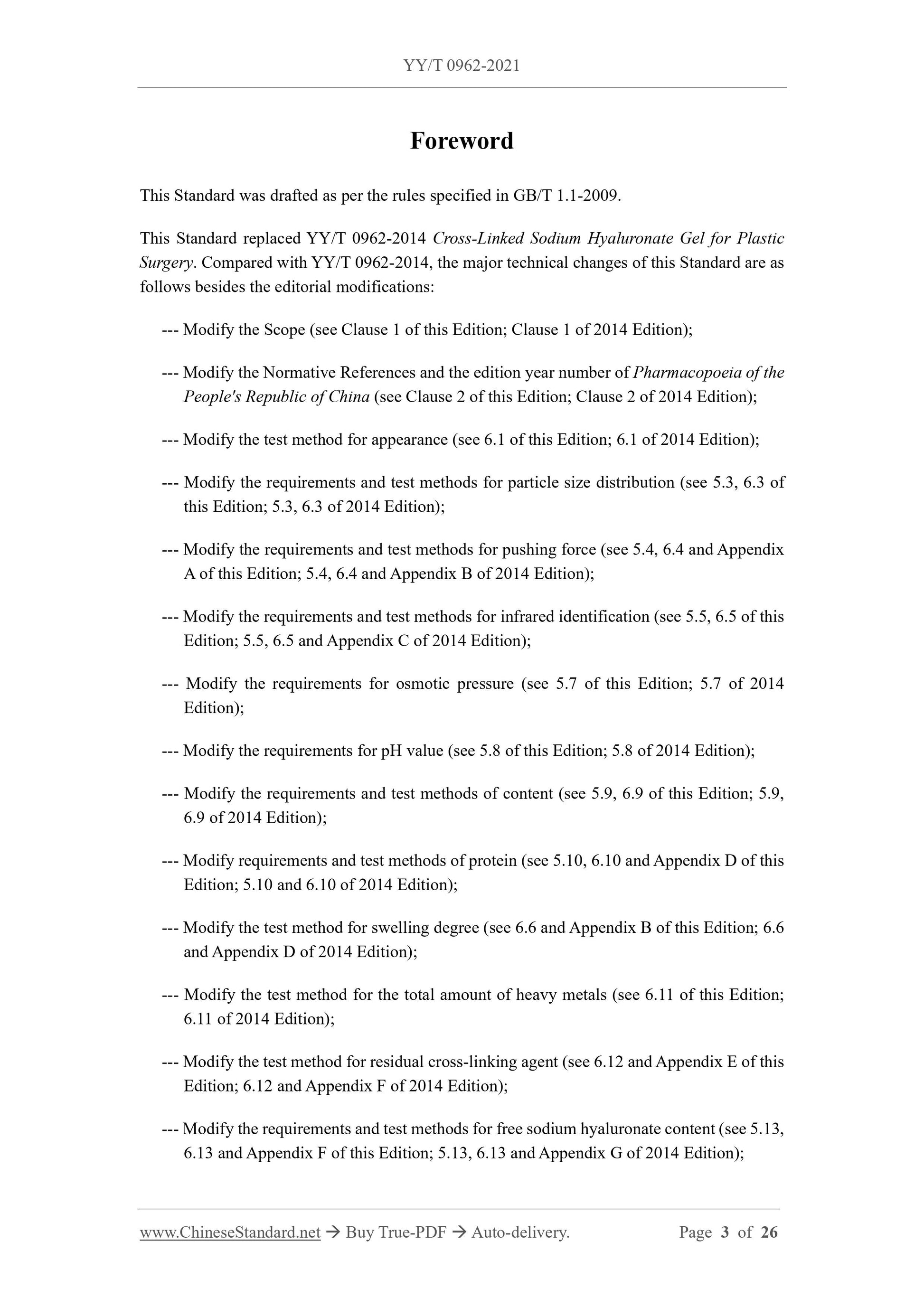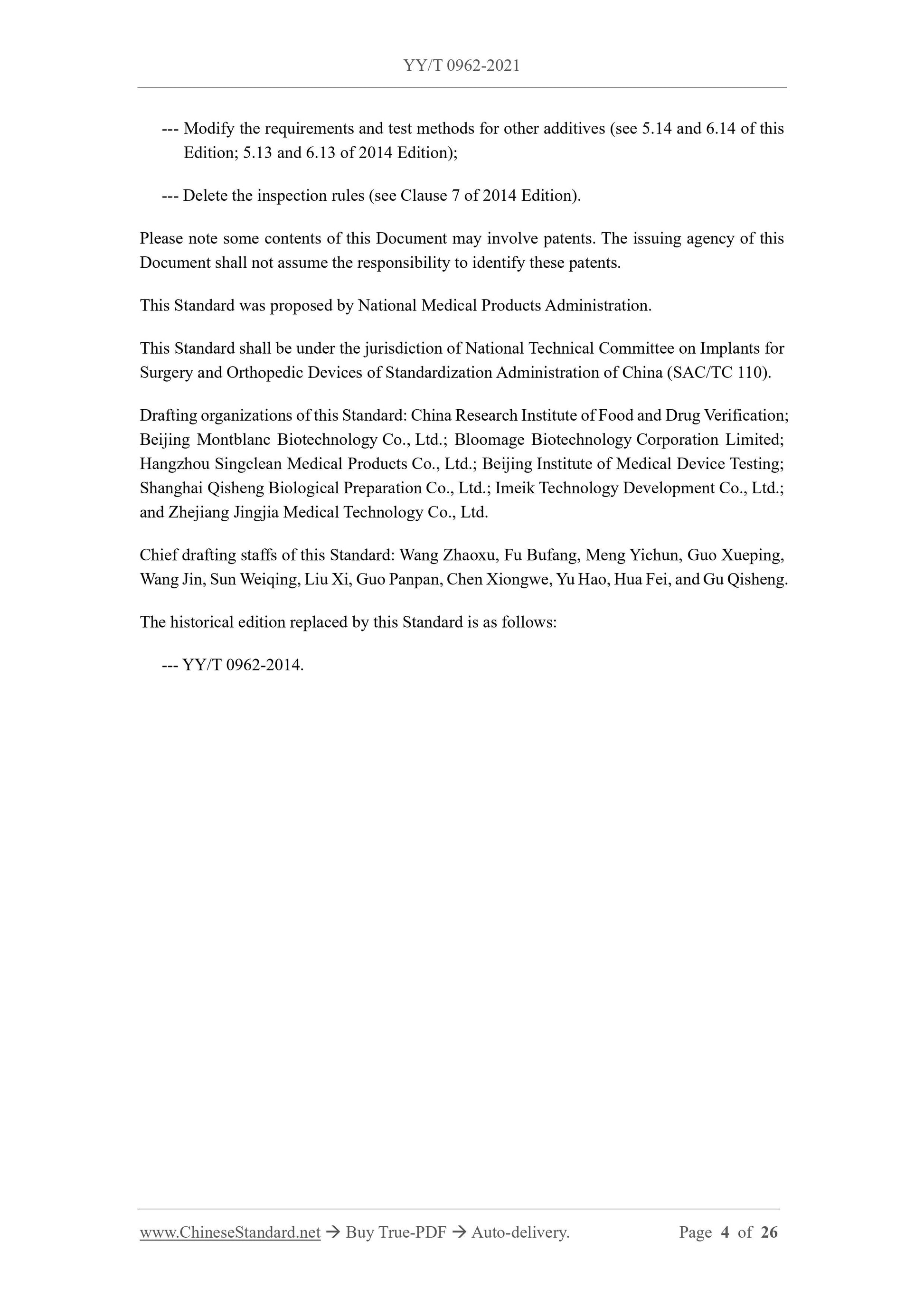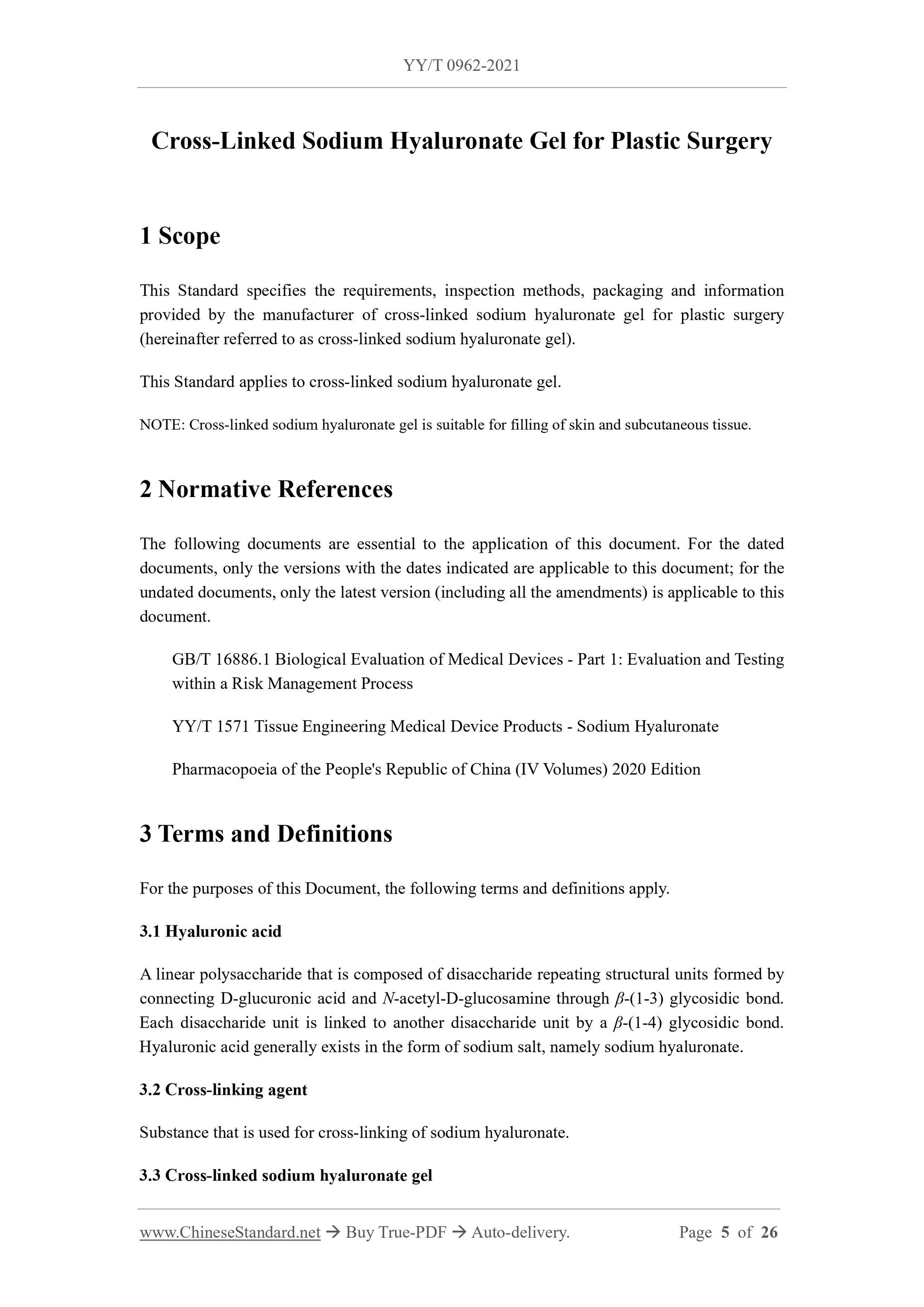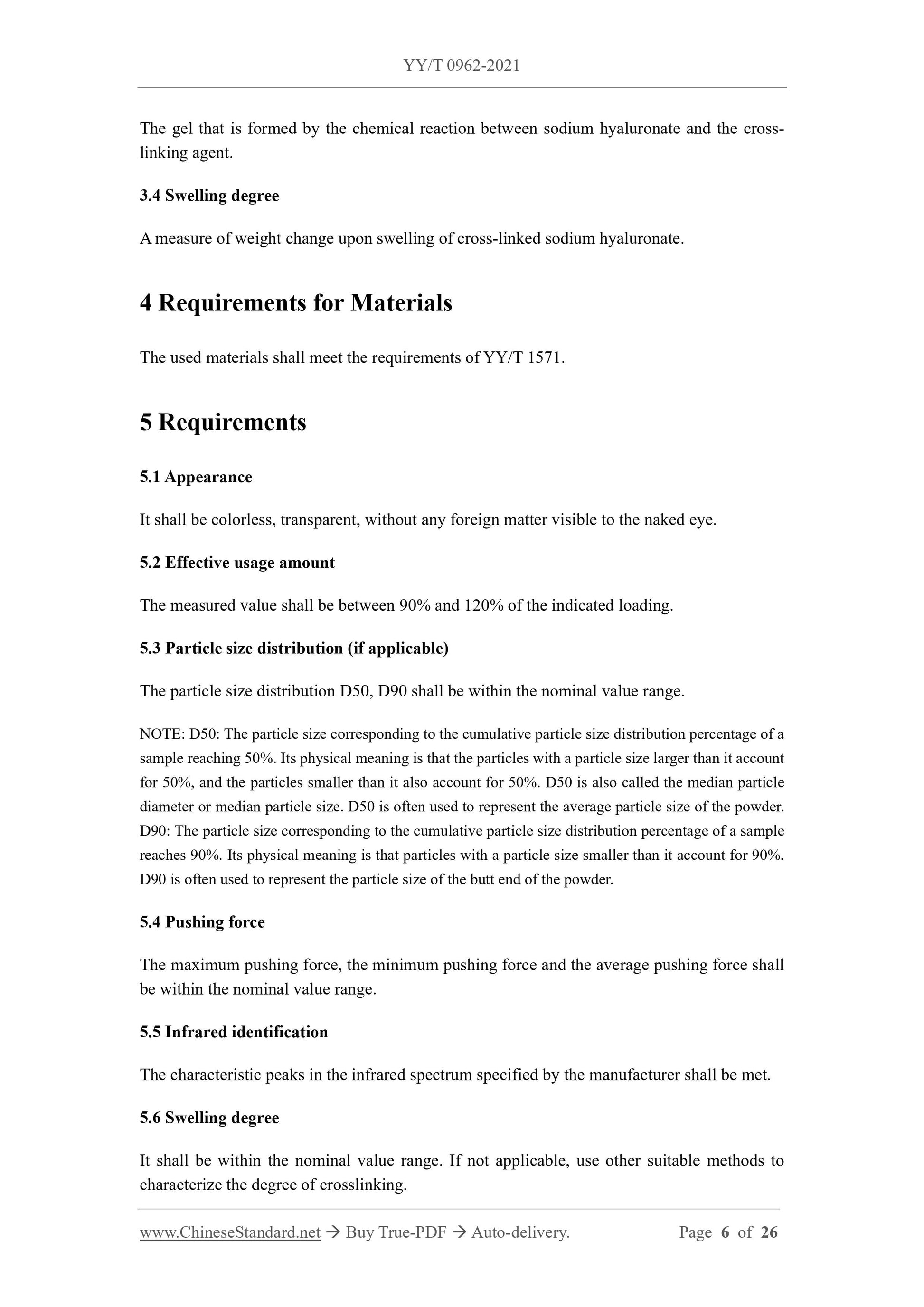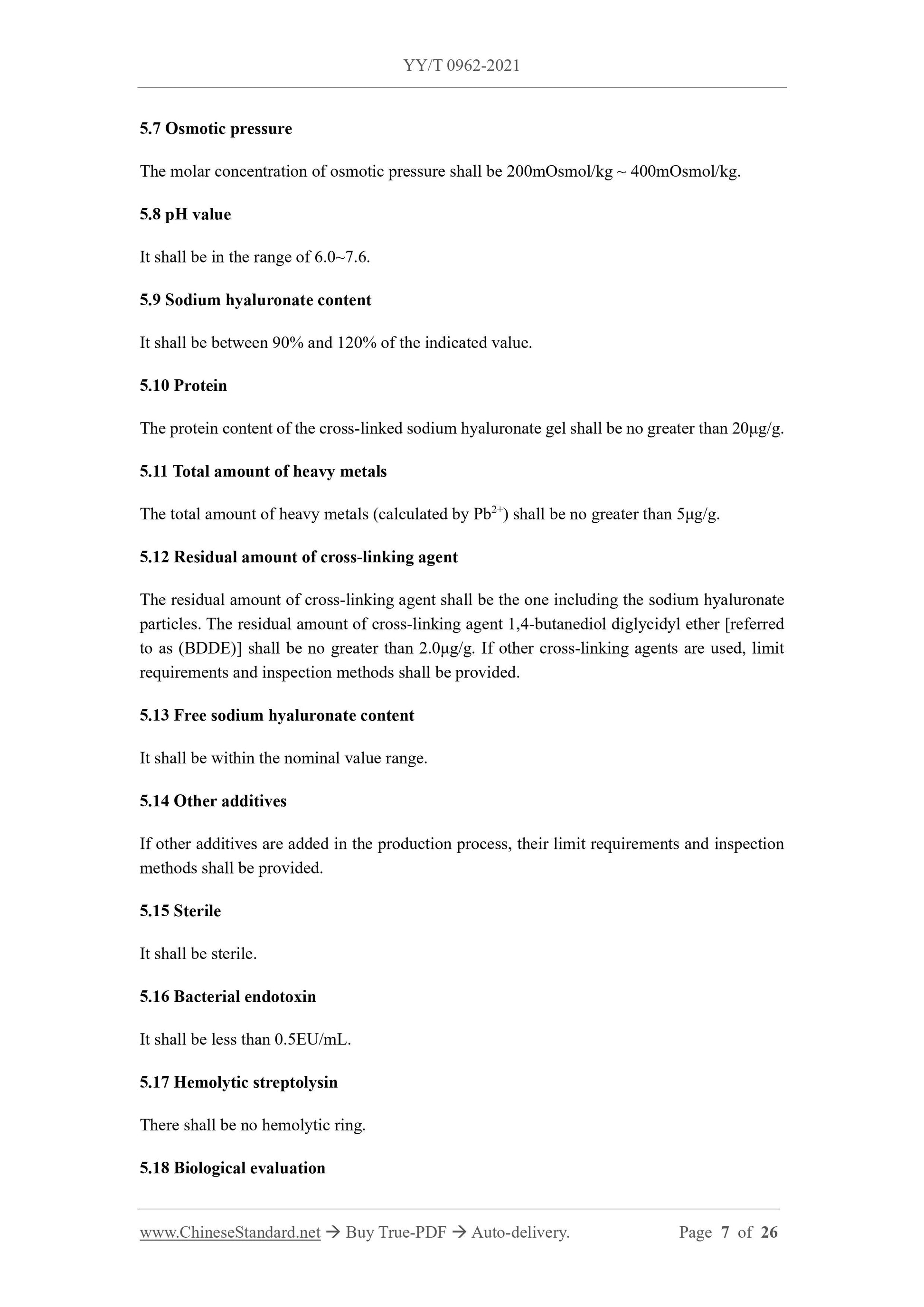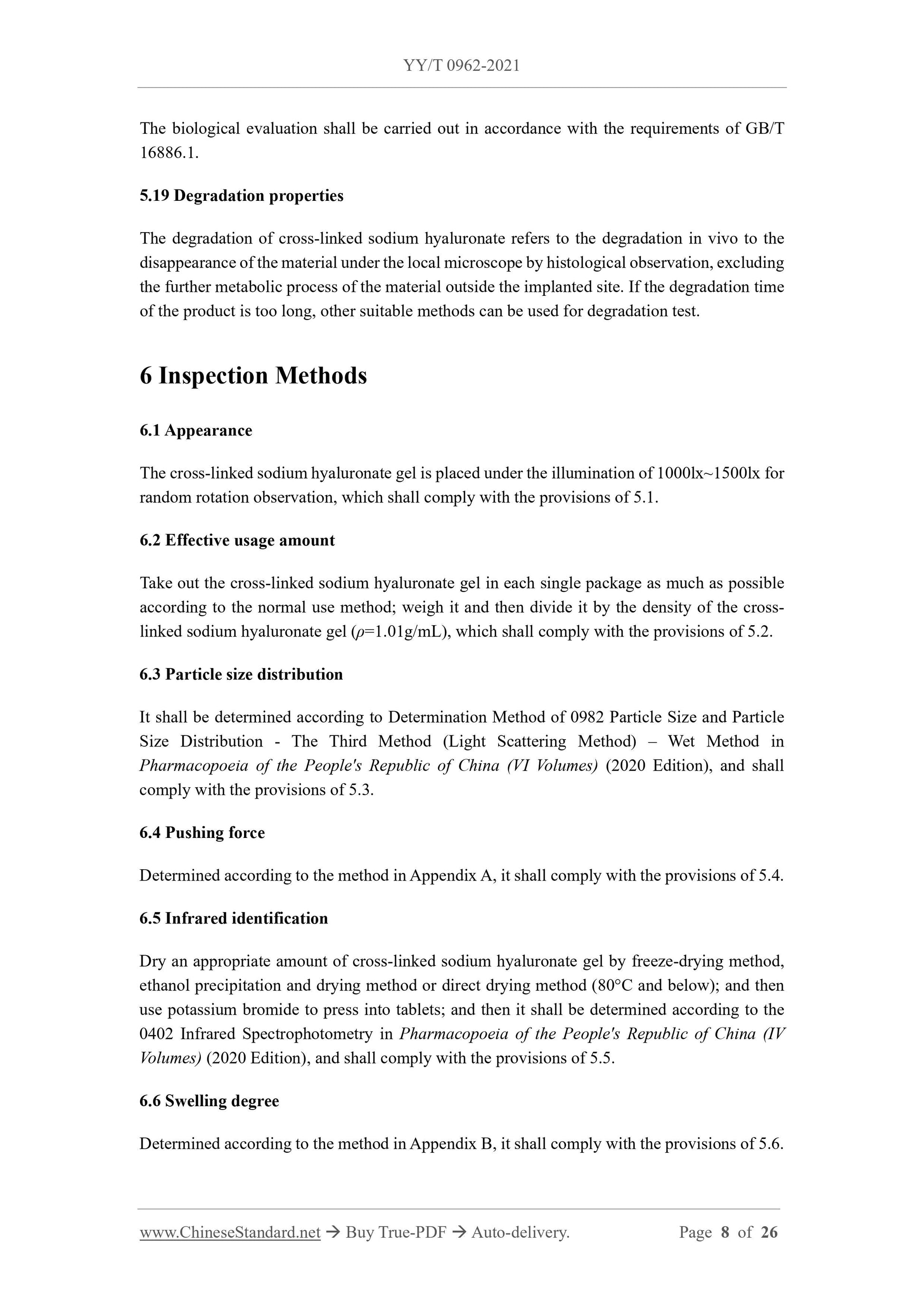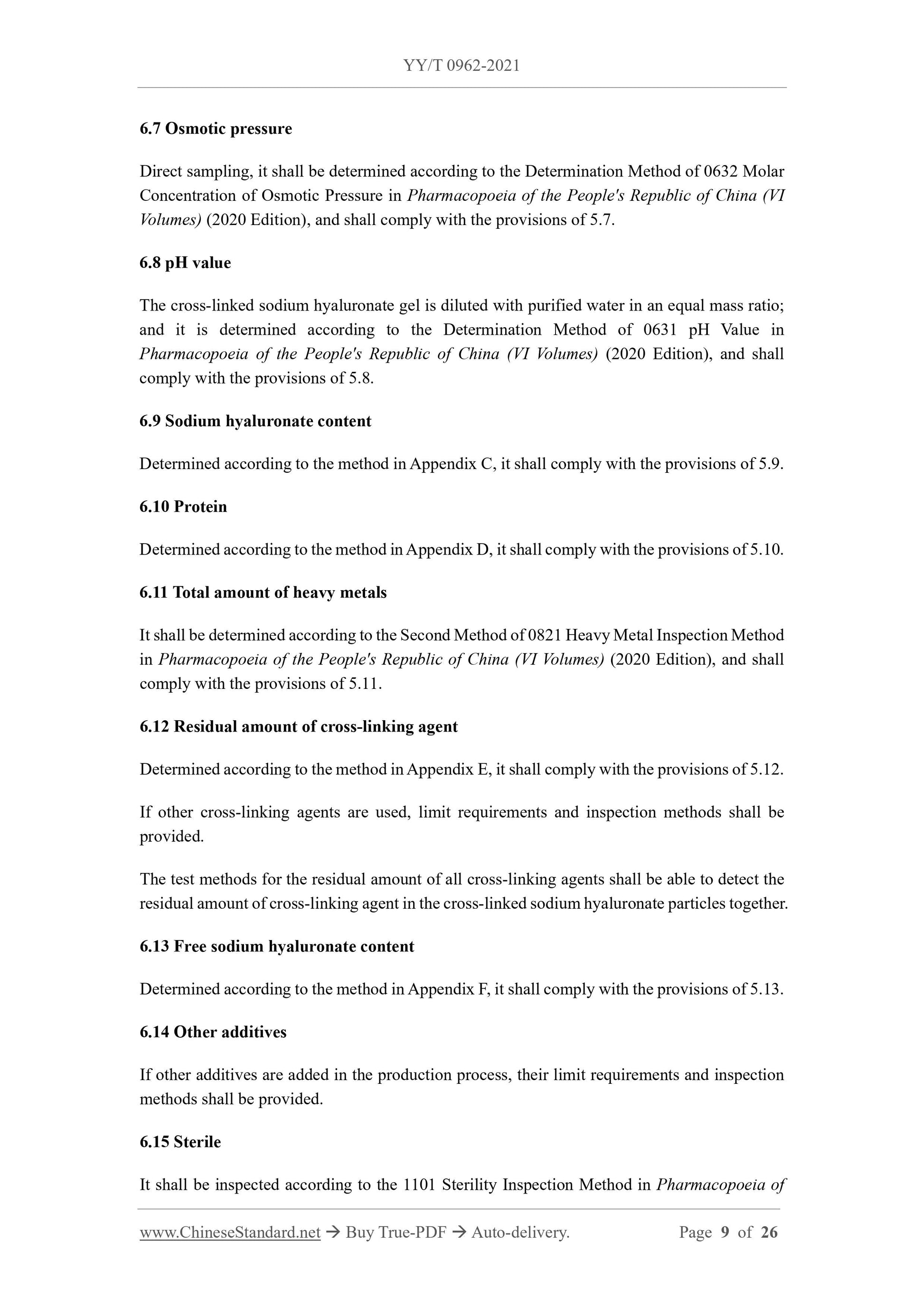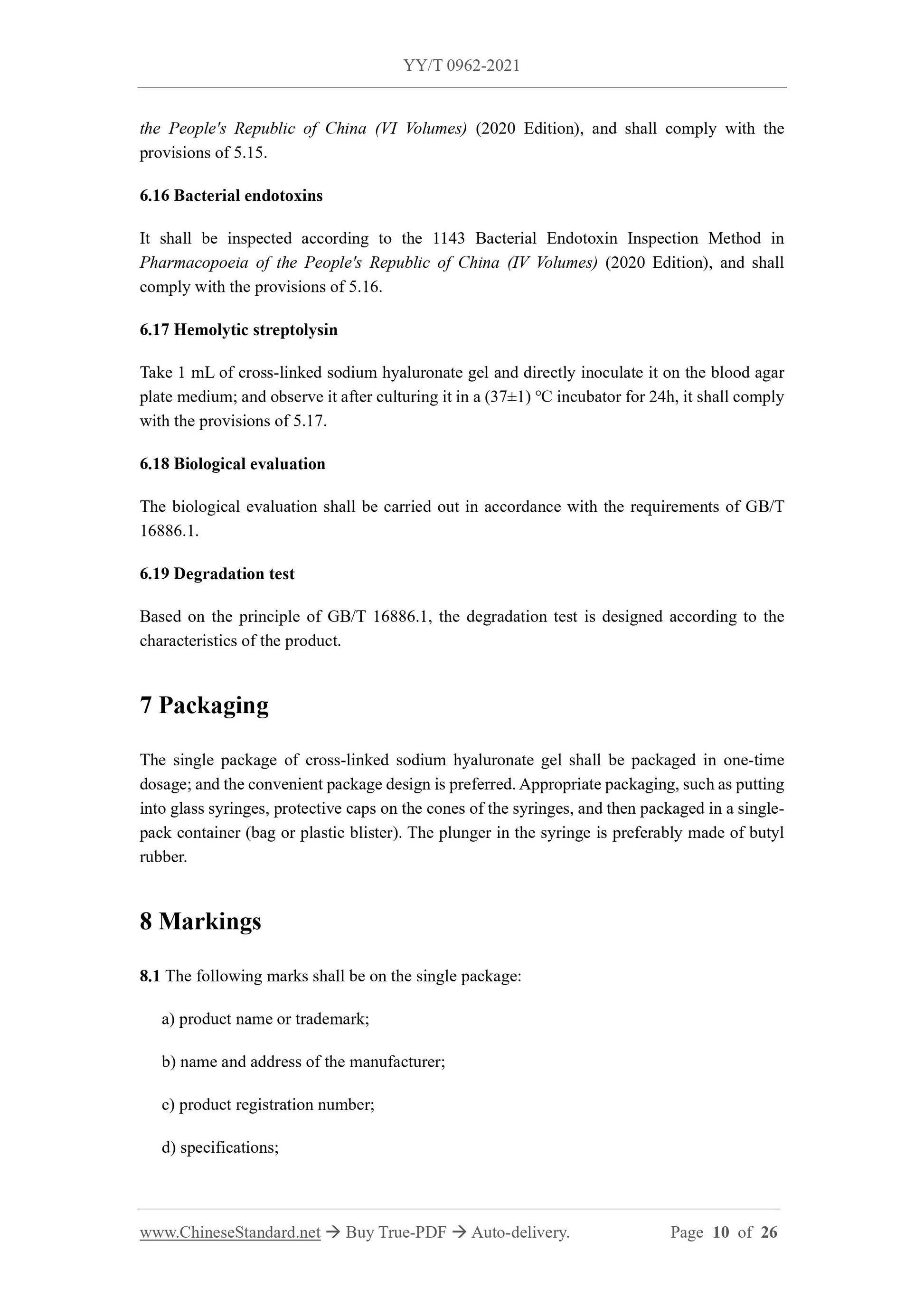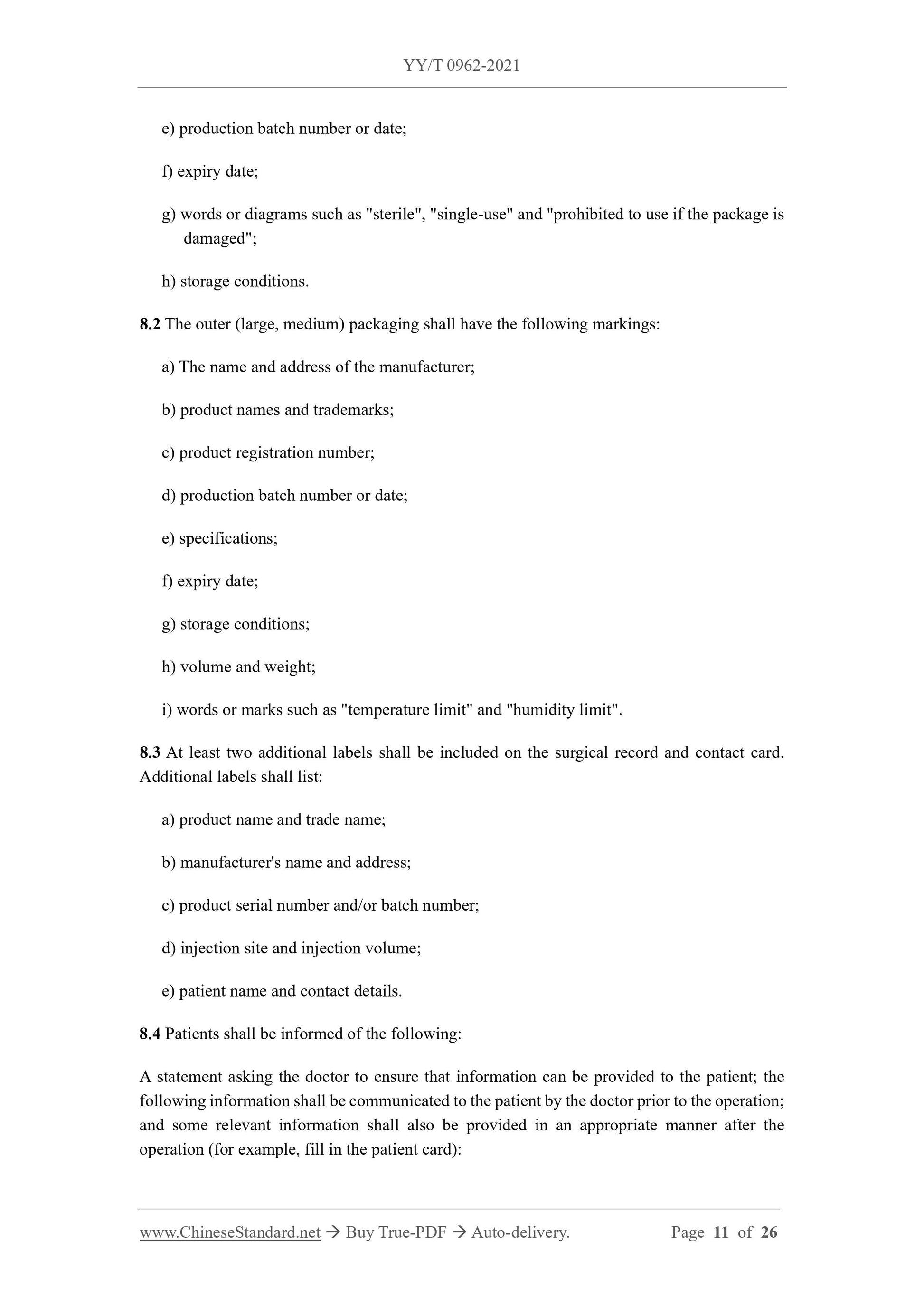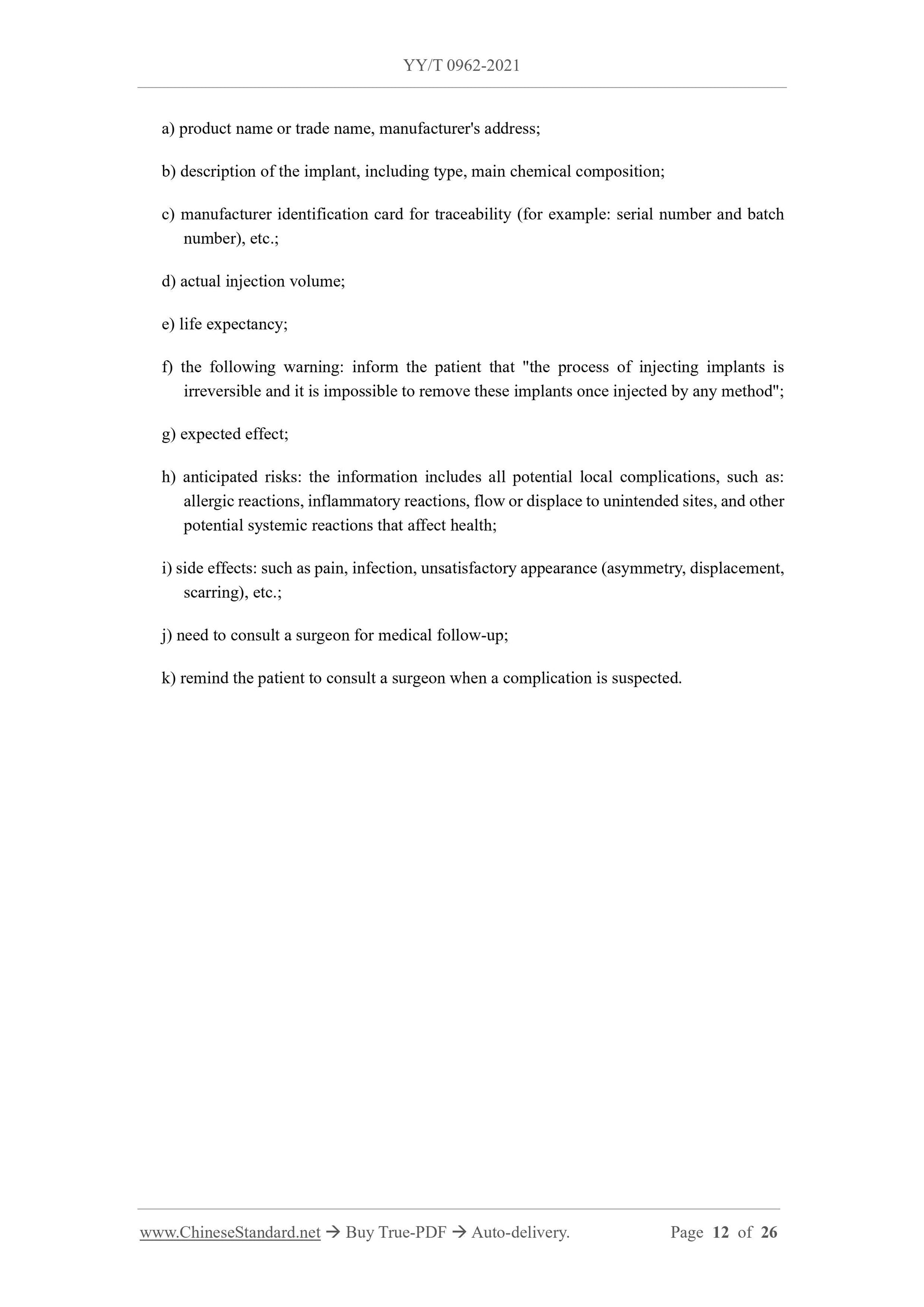1
/
of
12
PayPal, credit cards. Download editable-PDF & invoice in 1 second!
YY/T 0962-2021 English PDF (YYT0962-2021)
YY/T 0962-2021 English PDF (YYT0962-2021)
Regular price
$395.00 USD
Regular price
Sale price
$395.00 USD
Unit price
/
per
Shipping calculated at checkout.
Couldn't load pickup availability
Delivery: 3 seconds. Download true-PDF + Invoice.
Get QUOTATION in 1-minute: Click YY/T 0962-2021
Historical versions: YY/T 0962-2021
Preview True-PDF (Reload/Scroll if blank)
YY/T 0962-2021: Cross-linked sodium hyaluronate gel for plastic surgery
YY/T 0962-2021
PHARMACEUTICAL INDUSTRY STANDARD
OF THE PEOPLE’S REPUBLIC OF CHINA
ICS 11.040.40
C 45
Replacing YY/T 0962-2014
Cross-Linked Sodium Hyaluronate Gel for Plastic Surgery
ISSUED ON: SEPTEMBER 06, 2021
IMPLEMENTED ON: SEPTEMBER 01, 2022
Issued by: National Medical Products Administration
Table of Contents
Foreword ... 3
1 Scope ... 5
2 Normative References ... 5
3 Terms and Definitions ... 5
4 Requirements for Materials ... 6
5 Requirements ... 6
6 Inspection Methods ... 8
7 Packaging ... 10
8 Markings ... 10
Appendix A (Normative) Determination of Pushing Force ... 13
Appendix B (Normative) Determination of Swelling Degree ... 14
Appendix C (Normative) Determination of Sodium Hyaluronate Content ... 15
Appendix D (Normative) Determination of Protein Content ... 18
Appendix E (Normative) Determination of Residual Amount of Crosslinking Agent
1,4-Butanediol Diglycidyl Ether (BDDE) ... 20
Appendix F (Normative) Determination of Free Sodium Hyaluronate Content ... 24
Cross-Linked Sodium Hyaluronate Gel for Plastic Surgery
1 Scope
This Standard specifies the requirements, inspection methods, packaging and information
provided by the manufacturer of cross-linked sodium hyaluronate gel for plastic surgery
(hereinafter referred to as cross-linked sodium hyaluronate gel).
This Standard applies to cross-linked sodium hyaluronate gel.
NOTE: Cross-linked sodium hyaluronate gel is suitable for filling of skin and subcutaneous tissue.
2 Normative References
The following documents are essential to the application of this document. For the dated
documents, only the versions with the dates indicated are applicable to this document; for the
undated documents, only the latest version (including all the amendments) is applicable to this
document.
GB/T 16886.1 Biological Evaluation of Medical Devices - Part 1: Evaluation and Testing
within a Risk Management Process
YY/T 1571 Tissue Engineering Medical Device Products - Sodium Hyaluronate
Pharmacopoeia of the People's Republic of China (IV Volumes) 2020 Edition
3 Terms and Definitions
For the purposes of this Document, the following terms and definitions apply.
3.1 Hyaluronic acid
A linear polysaccharide that is composed of disaccharide repeating structural units formed by
connecting D-glucuronic acid and N-acetyl-D-glucosamine through β-(1-3) glycosidic bond.
Each disaccharide unit is linked to another disaccharide unit by a β-(1-4) glycosidic bond.
Hyaluronic acid generally exists in the form of sodium salt, namely sodium hyaluronate.
3.2 Cross-linking agent
Substance that is used for cross-linking of sodium hyaluronate.
3.3 Cross-linked sodium hyaluronate gel
The biological evaluation shall be carried out in accordance with the requirements of GB/T
16886.1.
5.19 Degradation properties
The degradation of cross-linked sodium hyaluronate refers to the degradation in vivo to the
disappearance of the material under the local microscope by histological observation, excluding
the further metabolic process of the material outside the implanted site. If the degradation time
of the product is too long, other suitable methods can be used for degradation test.
6 Inspection Methods
6.1 Appearance
The cross-linked sodium hyaluronate gel is placed under the illumination of 1000lx~1500lx for
random rotation observation, which shall comply with the provisions of 5.1.
6.2 Effective usage amount
Take out the cross-linked sodium hyaluronate gel in each single package as much as possible
according to the normal use method; weigh it and then divide it by the density of the cross-
linked sodium hyaluronate gel (ρ=1.01g/mL), which shall comply with the provisions of 5.2.
6.3 Particle size distribution
It shall be determined according to Determination Method of 0982 Particle Size and Particle
Size Distribution - The Third Method (Light Scattering Method) – Wet Method in
Pharmacopoeia of the People's Republic of China (VI Volumes) (2020 Edition), and shall
comply with the provisions of 5.3.
6.4 Pushing force
Determined according to the method in Appendix A, it shall comply with the provisions of 5.4.
6.5 Infrared identification
Dry an appropriate amount of cross-linked sodium hyaluronate gel by freeze-drying method,
ethanol precipitation and drying method or direct drying method (80°C and below); and then
use potassium bromide to press into tablets; and then it shall be determined according to the
0402 Infrared Spectrophotometry in Pharmacopoeia of the People's Republic of China (IV
Volumes) (2020 Edition), and shall comply with the provisions of 5.5.
6.6 Swelling degree
Determined according to the method in Appendix B, it shall comply with the provisions of 5.6.
6.7 Osmotic pressure
Direct sampling, it shall be determined according to the Determination Method of 0632 Molar
Concentration of Osmotic Pressure in Pharmacopoeia of the People's Republic of China (VI
Volumes) (2020 Edition), and shall comply with the provisions of 5.7.
6.8 pH value
The cross-linked sodium hyaluronate gel is diluted with purified water in an equal mass ratio;
and it is determined according to the Determination Method of 0631 pH Value in
Pharmacopoeia of the People's Republic of China (VI Volumes) (2020 Edition), and shall
comply with the provisions of 5.8.
6.9 Sodium hyaluronate content
Determined according to the method in Appendix C, it shall comply with the provisions of 5.9.
6.10 Protein
Determined according to the method in Appendix D, it shall comply with the provisions of 5.10.
6.11 Total amount of heavy metals
It shall be determined according to the Second Method of 0821 Heavy Metal Inspection Method
in Pharmacopoeia of the People's Republic of China (VI Volumes) (2020 Edition), and shall
comply with the provisions of 5.11.
6.12 Residual amount of cross-linking agent
Determined according to the method in Appendix E, it shall comply with the provisions of 5.12.
If other cross-linking agents are used, limit requirements and inspection methods shall be
provided.
The test methods for the residual amount of all cross-linking agents shall be able to detect the
residual amount of cross-linking agent in the cross-linked sodium hyaluronate particles together.
6.13 Free sodium hyaluronate content
Determined according to the method in Appendix F, it shall comply with the provisions of 5.13.
6.14 Other additives
If other additives are added in the production process, their limit requirements and inspection
methods shall be provided.
6.15 Sterile
It shall be inspected according to the 1101 Sterility Inspection Method in Pharmacopoeia of
Appendix A
(Normative)
Determination of Pushing Force
A.1 Principle
In this test, the injection core rod is pushed at a constant speed; and the injection needle is
installed during the test to simulate the actual use situation. Push the core rod at a constant
speed; the sample in the syringe is pushed out through the needle; and the push force curve is
obtained. From the pushing force curve, the change of the pushing force during the extrusion
process of the sample can be observed. If the pushing force is small, the sample is easily
extruded; if the pushing force is large, the sample is difficult extruded. In addition, if the high
and low drop of the pushing force is large, it shall indicate the sample has uneven dispersion or
aggregation and concentration, which shall also affect the chirality during injection.
A...
Get QUOTATION in 1-minute: Click YY/T 0962-2021
Historical versions: YY/T 0962-2021
Preview True-PDF (Reload/Scroll if blank)
YY/T 0962-2021: Cross-linked sodium hyaluronate gel for plastic surgery
YY/T 0962-2021
PHARMACEUTICAL INDUSTRY STANDARD
OF THE PEOPLE’S REPUBLIC OF CHINA
ICS 11.040.40
C 45
Replacing YY/T 0962-2014
Cross-Linked Sodium Hyaluronate Gel for Plastic Surgery
ISSUED ON: SEPTEMBER 06, 2021
IMPLEMENTED ON: SEPTEMBER 01, 2022
Issued by: National Medical Products Administration
Table of Contents
Foreword ... 3
1 Scope ... 5
2 Normative References ... 5
3 Terms and Definitions ... 5
4 Requirements for Materials ... 6
5 Requirements ... 6
6 Inspection Methods ... 8
7 Packaging ... 10
8 Markings ... 10
Appendix A (Normative) Determination of Pushing Force ... 13
Appendix B (Normative) Determination of Swelling Degree ... 14
Appendix C (Normative) Determination of Sodium Hyaluronate Content ... 15
Appendix D (Normative) Determination of Protein Content ... 18
Appendix E (Normative) Determination of Residual Amount of Crosslinking Agent
1,4-Butanediol Diglycidyl Ether (BDDE) ... 20
Appendix F (Normative) Determination of Free Sodium Hyaluronate Content ... 24
Cross-Linked Sodium Hyaluronate Gel for Plastic Surgery
1 Scope
This Standard specifies the requirements, inspection methods, packaging and information
provided by the manufacturer of cross-linked sodium hyaluronate gel for plastic surgery
(hereinafter referred to as cross-linked sodium hyaluronate gel).
This Standard applies to cross-linked sodium hyaluronate gel.
NOTE: Cross-linked sodium hyaluronate gel is suitable for filling of skin and subcutaneous tissue.
2 Normative References
The following documents are essential to the application of this document. For the dated
documents, only the versions with the dates indicated are applicable to this document; for the
undated documents, only the latest version (including all the amendments) is applicable to this
document.
GB/T 16886.1 Biological Evaluation of Medical Devices - Part 1: Evaluation and Testing
within a Risk Management Process
YY/T 1571 Tissue Engineering Medical Device Products - Sodium Hyaluronate
Pharmacopoeia of the People's Republic of China (IV Volumes) 2020 Edition
3 Terms and Definitions
For the purposes of this Document, the following terms and definitions apply.
3.1 Hyaluronic acid
A linear polysaccharide that is composed of disaccharide repeating structural units formed by
connecting D-glucuronic acid and N-acetyl-D-glucosamine through β-(1-3) glycosidic bond.
Each disaccharide unit is linked to another disaccharide unit by a β-(1-4) glycosidic bond.
Hyaluronic acid generally exists in the form of sodium salt, namely sodium hyaluronate.
3.2 Cross-linking agent
Substance that is used for cross-linking of sodium hyaluronate.
3.3 Cross-linked sodium hyaluronate gel
The biological evaluation shall be carried out in accordance with the requirements of GB/T
16886.1.
5.19 Degradation properties
The degradation of cross-linked sodium hyaluronate refers to the degradation in vivo to the
disappearance of the material under the local microscope by histological observation, excluding
the further metabolic process of the material outside the implanted site. If the degradation time
of the product is too long, other suitable methods can be used for degradation test.
6 Inspection Methods
6.1 Appearance
The cross-linked sodium hyaluronate gel is placed under the illumination of 1000lx~1500lx for
random rotation observation, which shall comply with the provisions of 5.1.
6.2 Effective usage amount
Take out the cross-linked sodium hyaluronate gel in each single package as much as possible
according to the normal use method; weigh it and then divide it by the density of the cross-
linked sodium hyaluronate gel (ρ=1.01g/mL), which shall comply with the provisions of 5.2.
6.3 Particle size distribution
It shall be determined according to Determination Method of 0982 Particle Size and Particle
Size Distribution - The Third Method (Light Scattering Method) – Wet Method in
Pharmacopoeia of the People's Republic of China (VI Volumes) (2020 Edition), and shall
comply with the provisions of 5.3.
6.4 Pushing force
Determined according to the method in Appendix A, it shall comply with the provisions of 5.4.
6.5 Infrared identification
Dry an appropriate amount of cross-linked sodium hyaluronate gel by freeze-drying method,
ethanol precipitation and drying method or direct drying method (80°C and below); and then
use potassium bromide to press into tablets; and then it shall be determined according to the
0402 Infrared Spectrophotometry in Pharmacopoeia of the People's Republic of China (IV
Volumes) (2020 Edition), and shall comply with the provisions of 5.5.
6.6 Swelling degree
Determined according to the method in Appendix B, it shall comply with the provisions of 5.6.
6.7 Osmotic pressure
Direct sampling, it shall be determined according to the Determination Method of 0632 Molar
Concentration of Osmotic Pressure in Pharmacopoeia of the People's Republic of China (VI
Volumes) (2020 Edition), and shall comply with the provisions of 5.7.
6.8 pH value
The cross-linked sodium hyaluronate gel is diluted with purified water in an equal mass ratio;
and it is determined according to the Determination Method of 0631 pH Value in
Pharmacopoeia of the People's Republic of China (VI Volumes) (2020 Edition), and shall
comply with the provisions of 5.8.
6.9 Sodium hyaluronate content
Determined according to the method in Appendix C, it shall comply with the provisions of 5.9.
6.10 Protein
Determined according to the method in Appendix D, it shall comply with the provisions of 5.10.
6.11 Total amount of heavy metals
It shall be determined according to the Second Method of 0821 Heavy Metal Inspection Method
in Pharmacopoeia of the People's Republic of China (VI Volumes) (2020 Edition), and shall
comply with the provisions of 5.11.
6.12 Residual amount of cross-linking agent
Determined according to the method in Appendix E, it shall comply with the provisions of 5.12.
If other cross-linking agents are used, limit requirements and inspection methods shall be
provided.
The test methods for the residual amount of all cross-linking agents shall be able to detect the
residual amount of cross-linking agent in the cross-linked sodium hyaluronate particles together.
6.13 Free sodium hyaluronate content
Determined according to the method in Appendix F, it shall comply with the provisions of 5.13.
6.14 Other additives
If other additives are added in the production process, their limit requirements and inspection
methods shall be provided.
6.15 Sterile
It shall be inspected according to the 1101 Sterility Inspection Method in Pharmacopoeia of
Appendix A
(Normative)
Determination of Pushing Force
A.1 Principle
In this test, the injection core rod is pushed at a constant speed; and the injection needle is
installed during the test to simulate the actual use situation. Push the core rod at a constant
speed; the sample in the syringe is pushed out through the needle; and the push force curve is
obtained. From the pushing force curve, the change of the pushing force during the extrusion
process of the sample can be observed. If the pushing force is small, the sample is easily
extruded; if the pushing force is large, the sample is difficult extruded. In addition, if the high
and low drop of the pushing force is large, it shall indicate the sample has uneven dispersion or
aggregation and concentration, which shall also affect the chirality during injection.
A...
Share
